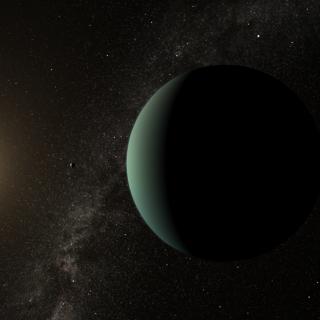- A novel technique has enabled a team of IAC researchers to be the first to analyse in detail the Earth’s atmosphere during a lunar eclipse
- The study determines those features that permit the existence of life on Earth and suggests that the search for life on other planets might be easier than previously thought
A team of researchers from the Instituto de Astrofísica de Canarias (IAC) has been the first to make a detailed study of the sunlight transmitted through the Earth’s atmosphere and reflected back to Earth by the Moon during a lunar eclipse. The method consists in analysing the atmosphere of the Earth as though it were a distant planet, to determine its principal biological markers (oxygen, carbon dioxide, water, methane, etc.) and then extrapolate these findings to new planets being discovered to see whether they possess the necessary conditions to harbour life.
“Until now there were only models that explained the terrestrial spectrum, and we’re the first to make measurements in real time during a lunar eclipse,” explains Enric Pallé, a member of the IAC research team. That is to say, the scientists have exploited the alignment of the Sun, Earth and Moon (in that order) to carry out their study. Putting it another way, if you were on the Moon’s surface during a lunar eclipse, you would see the opaque silhouette of the Earth surrounded by a ghostly ring of light due to the Earth’s atmosphere illuminated by the eclipsed Sun. One could say that the Moon is used as a mirror to observe the characteristics that permit life on our planet. These measurements were carried out at Roque de los Muchachos Observatory (La Palma) using the Nordic Optical Telescope and the William Herschel Telescope.
“Until now,” says IAC astronomer Rafael Barrena, “spectroscopic transits have been the ugly duckling among the observing techniques proposed for characterizing habitable planets, but the ugly duckling has now become a swan.” This is undoubtedly good news for future missions seeking life in the Universe. The characterization of an extrasolar planet could lead to a complete understanding of its chemistry, formation and evolution.
First fruits
“The basic conclusion of our work is that the characterization of exoplanetary atmospheres and the search for life outside the Solar System might not be as technically difficult as previously thought,” concludes IAC astronomer Eduardo L. Martín. The team were surprised by the results. Not only were the principal biological marker fingerprints (water, CO2 and oxygen) present in the spectrum, but the markers were also unmistakeably strong. “They are seen as very marked features; in other words, it will be easier than we first thought to identify them in an extrasolar planet,” IAC astronomer María Rosa Zapatero explains.
In this sense, one of the novel results of this investigation is that methane, scarcely present in the atmosphere, figures prominently in the spectrum. This means that if there is any trace of methane, however slight, in an exoplanet’s atmosphere it will be easily detectable. It should also be pointed out that other molecules (such as nitrogen, which constitutes 80 per cent of the Earth’s atmosphere) were detected, even though they were not predicted by theoretical models. “These results tell us that there is much room for improvement in our knowledge of the Earth. As has happened with recently discovered giant extrasolar planets, there is a certain margin for surprise and for unexpected results,” comments IAC researcher Pilar Montañés-Rodríguez.
A question of time
The last two decades have witnessed the discovery of hundreds of extrasolar planets, and there are more and more missions, both ground-based and space-borne, dedicated to the discovery of new ones. Once these planets are found, they are studied and characterized in an effort to see whether they possess suitable conditions for harbouring life.
Most extrasolar planet discoveries have been made by concentrating on how the hw the planet affects the light from the star it is orbiting. When a celestial body passes in front of a star, light from the star is transmitted through the atmosphere of the planet and is modified by that atmosphere’s inorganic chemical components (nitrogen, oxygen, methane, etc.). By studying the spectrum of the star before and after the transit event, the spectrum of the atmospheric transmission of the planet is obtained. To put it another way, we can study the planet’s atmosphere.
The researchers say that they now have a much clearer idea of how to find and recognize planets identical to the Earth, where life is possible. The study was published in the prestigious journal Nature, with the participation of IAC researchers Enric Pallé, María Rosa Zapatero Osorio, Pilar Montañés-Rodríguez, Rafael Barrena and Eduardo L. Martín (who is also affiliated to the Department of Physics of the University of Florida).
VÍDEO
- Preview
Lunar eclipse simulation
Further information
IAC Press Office
prensa [at] iac.es (prensa[at]iac[dot]es)
Telephone: +34 922 605371 / 679033049
Fax: +34 922 605396
- There will be a webcast talk on this topic this Friday, 12 June 2009, at the Instituto de Astrofísica de Canarias that can be followed through the streaming service at: www.iac.es/emisiones .



